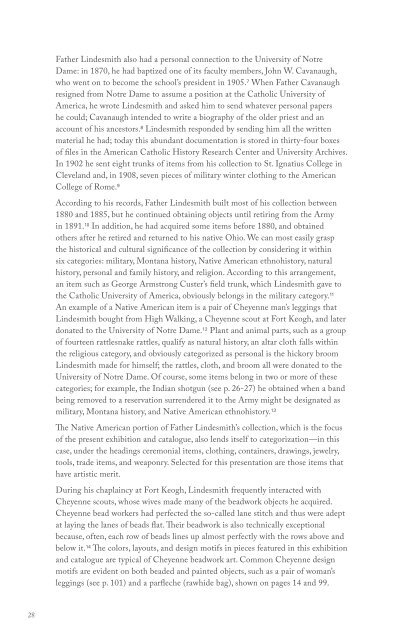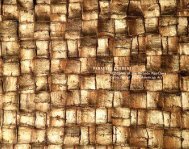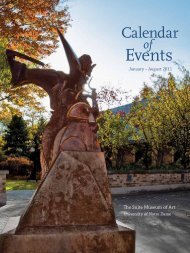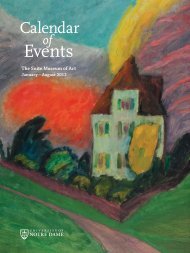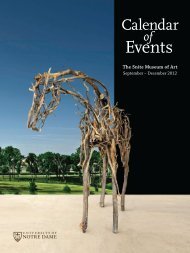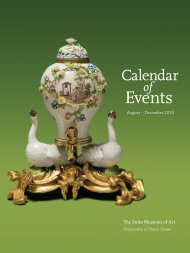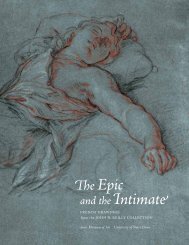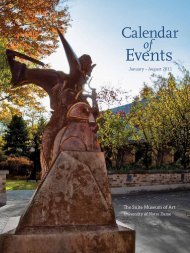HISTORY INTO ART AND ANTHROPOLOGY - Snite Museum of Art ...
HISTORY INTO ART AND ANTHROPOLOGY - Snite Museum of Art ...
HISTORY INTO ART AND ANTHROPOLOGY - Snite Museum of Art ...
You also want an ePaper? Increase the reach of your titles
YUMPU automatically turns print PDFs into web optimized ePapers that Google loves.
Father Lindesmith also had a personal connection to the University <strong>of</strong> Notre<br />
Dame: in 1870, he had baptized one <strong>of</strong> its faculty members, John W. Cavanaugh,<br />
who went on to become the school’s president in 1905. 7 When Father Cavanaugh<br />
resigned from Notre Dame to assume a position at the Catholic University <strong>of</strong><br />
America, he wrote Lindesmith and asked him to send whatever personal papers<br />
he could; Cavanaugh intended to write a biography <strong>of</strong> the older priest and an<br />
account <strong>of</strong> his ancestors. 8 Lindesmith responded by sending him all the written<br />
material he had; today this abundant documentation is stored in thirty-four boxes<br />
<strong>of</strong> files in the American Catholic History Research Center and University Archives.<br />
In 1902 he sent eight trunks <strong>of</strong> items from his collection to St. Ignatius College in<br />
Cleveland and, in 1908, seven pieces <strong>of</strong> military winter clothing to the American<br />
College <strong>of</strong> Rome. 9<br />
According to his records, Father Lindesmith built most <strong>of</strong> his collection between<br />
1880 and 1885, but he continued obtaining objects until retiring from the Army<br />
in 1891. 10 In addition, he had acquired some items before 1880, and obtained<br />
others after he retired and returned to his native Ohio. We can most easily grasp<br />
the historical and cultural significance <strong>of</strong> the collection by considering it within<br />
six categories: military, Montana history, Native American ethnohistory, natural<br />
history, personal and family history, and religion. According to this arrangement,<br />
an item such as George Armstrong Custer’s field trunk, which Lindesmith gave to<br />
the Catholic University <strong>of</strong> America, obviously belongs in the military category. 11<br />
An example <strong>of</strong> a Native American item is a pair <strong>of</strong> Cheyenne man’s leggings that<br />
Lindesmith bought from High Walking, a Cheyenne scout at Fort Keogh, and later<br />
donated to the University <strong>of</strong> Notre Dame. 12 Plant and animal parts, such as a group<br />
<strong>of</strong> fourteen rattlesnake rattles, qualify as natural history, an altar cloth falls within<br />
the religious category, and obviously categorized as personal is the hickory broom<br />
Lindesmith made for himself; the rattles, cloth, and broom all were donated to the<br />
University <strong>of</strong> Notre Dame. Of course, some items belong in two or more <strong>of</strong> these<br />
categories; for example, the Indian shotgun (see p. 26-27) he obtained when a band<br />
being removed to a reservation surrendered it to the Army might be designated as<br />
military, Montana history, and Native American ethnohistory. 13<br />
The Native American portion <strong>of</strong> Father Lindesmith’s collection, which is the focus<br />
<strong>of</strong> the present exhibition and catalogue, also lends itself to categorization—in this<br />
case, under the headings ceremonial items, clothing, containers, drawings, jewelry,<br />
tools, trade items, and weaponry. Selected for this presentation are those items that<br />
have artistic merit.<br />
During his chaplaincy at Fort Keogh, Lindesmith frequently interacted with<br />
Cheyenne scouts, whose wives made many <strong>of</strong> the beadwork objects he acquired.<br />
Cheyenne bead workers had perfected the so-called lane stitch and thus were adept<br />
at laying the lanes <strong>of</strong> beads flat. Their beadwork is also technically exceptional<br />
because, <strong>of</strong>ten, each row <strong>of</strong> beads lines up almost perfectly with the rows above and<br />
below it. 14 The colors, layouts, and design motifs in pieces featured in this exhibition<br />
and catalogue are typical <strong>of</strong> Cheyenne beadwork art. Common Cheyenne design<br />
motifs are evident on both beaded and painted objects, such as a pair <strong>of</strong> woman’s<br />
leggings (see p. 101) and a parfleche (rawhide bag), shown on pages 14 and 99.<br />
Some motifs the Northern Cheyenne workers used suggest their frequent association<br />
with Lakota relatives and, sometimes, allies; the motifs on the girl’s dress<br />
included here reflect that influence (see p. 43 and 93). 15<br />
Cheyenne bead workers tended to use a wider range <strong>of</strong> colors than those <strong>of</strong> most<br />
other Northern Plains cultures, for example, the light-blue Italian beads that are<br />
visible in the background color <strong>of</strong> the cradle beading, in the yoke <strong>of</strong> the girl’s dress,<br />
and in the woman’s leggings. 16 Other colors that Cheyenne bead workers used,<br />
some seen on the items included here, were white, dark or royal blue, dark green,<br />
black, rose, pink, yellow, orange, medium or mint green, and red or oxblood. The<br />
beaded moccasins shown on page 106-109 provide an excellent example <strong>of</strong> the<br />
vivid color work and complex layouts these Cheyenne achieved. The moccasins<br />
are designed in a traditional manner, with a border <strong>of</strong> two lanes, a group <strong>of</strong> lanes<br />
running up the center from toe to tongue (repeating the border arrangement), one<br />
lane running over the instep just in front <strong>of</strong> the tongue, two narrow lanes going<br />
along the top <strong>of</strong> the border from the cross lane back to the heel seam, and one more<br />
lane running up the heal seam. 17<br />
Cheyenne bead workers employed three basic designs. The first two were stripes,<br />
as seen in the awl case on page 103, and geometric figures, (mostly squares and<br />
rectangles), such as on the girl’s dress mentioned above. The third basic motif—<br />
animal figures—is not represented in this set <strong>of</strong> beaded objects. The bead workers<br />
were apt to depict solid geometric figures or to put contrasting colors somewhere<br />
inside a geometric figure, such as the stepped-triangle design (as seen on the cradle<br />
and the girl’s dress); this design refers to Sweet Medicine’s Cave and Bear Butte—<br />
the sacred mountain in Cheyenne religion. 18<br />
Parfleche painting has always been geometric. In general, Great Plains women<br />
used geometric designs for beading and painting, whereas men most <strong>of</strong>ten used<br />
realistic designs. 19 This is most clearly seen by comparing White Swan’s muslin<br />
(see the illustrations in Candace Greene’s essay and on p. 61, 66-67) and Măeăbut’s<br />
parfleche (see p. 14 and 99). One can also compare the beading on a pair <strong>of</strong> Lakota<br />
dolls with the shield carried by the male doll (see p. 119); men painted shields.<br />
The woven pieces featured in this exhibition and catalogue include four baskets<br />
and one apron (see pp. 86-87, 88, and 91). Lindesmith likely collected three<br />
<strong>of</strong> the baskets on one <strong>of</strong> his trips east. In 1888 he traveled to Niagara Falls, where<br />
this type <strong>of</strong> brightly colored ash-splint basketry was made for the tourist trade.<br />
The bright, so-called Easter egg colors are a characteristic feature <strong>of</strong> these baskets. 20<br />
The fourth basket and the apron are from northwestern California but were in<br />
his collection before he traveled to that part <strong>of</strong> the country. He noted on the tag<br />
accompanying this basket that it had been sent to him as a symbol <strong>of</strong> ridicule for<br />
his being a Union supporter during the Civil War. 21 Woven into the girl’s apron<br />
are strands <strong>of</strong> maidenhair fern (black) and bear grass (pale yellow). Also on the<br />
apron are several large glass beads <strong>of</strong> the kind traded during the mid-nineteenth<br />
century on the West Coast by Russian Fur Trade Company agents to various Native<br />
American groups stretching from Alaska to Northern California; these are interspersed<br />
among the large pine nut beads (p. 86). 22<br />
28 29


